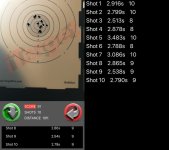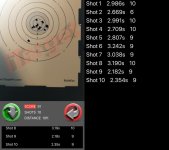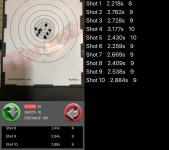I was at the range before work yesterday morning doing some speed drills with my Kimber 9mm 1911.
At one point I noted that some of my shots were going left, out of the A zone at 15 meters. I slowed down my shooting and then noticed that there was very little daylight each side of the front sight at that range. Speeding up again I saw that I was favouring the right side of the front sight a little and decided that I would widen the rear sight a bit to see if the leftward shots improved.
Afterwards I was sitting outside the Club room with a few of the guys and told them what had happened. I then mentioned that some of the best shooting I had ever done was with my Springfield .45, before I put on adjustable sights. The rear sight notch seemed to be wide enough to drive a Mack truck through while the front sight had been this very small nub on the end of the slide. The last time I shot the pistol with those sights I scored 26 A’s and 6 C’s on two co secutive 32 round courses of fire.
One of the others, a very experienced shooter, said that he always widened his rear sight to the point that it was twice as wide as his front sight.
Getting home today in daylight I headed out to the shed where I measured the width of the Kimber’s front sight at 0.1395”. The notch in the rear sight mic’d out to 0.1480”. Using a small needle file I widened the rear notch to 0.1530”, which seems ample to me. I can see daylight well on both sides of the front sight and on Wednesday I’ll test it out. (I was pretty careful to take the same number f file strokes each side, but a bit of windage adjustment may be needed).
But it made me think, what ratio between front and rear sights do other shooters like/use? And does it really make a difference?
At one point I noted that some of my shots were going left, out of the A zone at 15 meters. I slowed down my shooting and then noticed that there was very little daylight each side of the front sight at that range. Speeding up again I saw that I was favouring the right side of the front sight a little and decided that I would widen the rear sight a bit to see if the leftward shots improved.
Afterwards I was sitting outside the Club room with a few of the guys and told them what had happened. I then mentioned that some of the best shooting I had ever done was with my Springfield .45, before I put on adjustable sights. The rear sight notch seemed to be wide enough to drive a Mack truck through while the front sight had been this very small nub on the end of the slide. The last time I shot the pistol with those sights I scored 26 A’s and 6 C’s on two co secutive 32 round courses of fire.
One of the others, a very experienced shooter, said that he always widened his rear sight to the point that it was twice as wide as his front sight.
Getting home today in daylight I headed out to the shed where I measured the width of the Kimber’s front sight at 0.1395”. The notch in the rear sight mic’d out to 0.1480”. Using a small needle file I widened the rear notch to 0.1530”, which seems ample to me. I can see daylight well on both sides of the front sight and on Wednesday I’ll test it out. (I was pretty careful to take the same number f file strokes each side, but a bit of windage adjustment may be needed).
But it made me think, what ratio between front and rear sights do other shooters like/use? And does it really make a difference?




